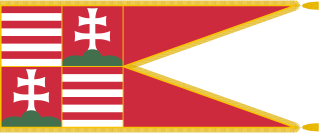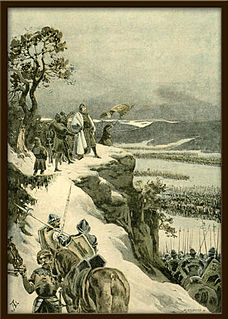 W
WIn the Late Middle Ages, the Kingdom of Hungary, a country in Central Europe, experienced a period of interregnum in the early 14th century. Royal power was restored under Charles I (1308–1342), a scion of the Capetian House of Anjou. Gold and silver mines opened in his reign produced about one third of the world's total production up until the 1490s. The kingdom reached the peak of its power under Louis the Great (1342–1382) who led military campaigns against Lithuania, southern Italy and other faraway territories.
 W
WThe Austrian–Hungarian War was a military conflict between the Kingdom of Hungary under Mathias Corvinus and the Habsburg Archduchy of Austria under Frederick V. The war lasted from 1477 to 1488 and resulted in significant gains for Matthias, which humiliated Frederick, but which were reversed upon Matthias' sudden death in 1490.
 W
WThe Bohemian War (1468–1478) began when the Kingdom of Bohemia was invaded by the king of Hungary, Matthias Corvinus. Matthias invaded with the pretext of returning Bohemia to Catholicism; at the time, it was ruled by the Hussite king, George of Poděbrad. Matthias' invasion was largely successful, leading to his acquisition of the southern and eastern parts of the country. Its core lands however, centered on Prague, were never taken. Ultimately both Matthias and Poděbrad would proclaim themselves king, though neither ever acquired all the necessary subordinate titles. When Poděbrad died in 1471, his successor Vladislaus II continued the fight against Matthias. In 1478, the war ended following the treaties of Brno and the Olomouc. Upon Matthias' death in 1490, Vladislaus would succeed him as king of both Hungary and Bohemia.
 W
WThe Crusade of Varna was an unsuccessful military campaign mounted by several European monarchs to check the expansion of the Ottoman Empire into Central Europe, specifically the Balkans between 1443 and 1444. It was called by Pope Eugene IV on 1 January 1443 and led by King Władysław III of Poland, John Hunyadi, Voivode of Transylvania, and Duke Philip the Good of Burgundy.
 W
WThe Ottoman–Hungarian Wars were a series of battles between the Ottoman Empire and the medieval Kingdom of Hungary. Following the Byzantine Civil War, the Ottoman capture of Gallipoli, and the decisive Battle of Kosovo, the Ottoman Empire was poised to conquer the entirety of the Balkans and also sought and expressed desire to expand further north into Central Europe beginning with the Hungarian lands.
 W
WThe Peace of Olomouc was signed on 2 April 1479 between Matthias Corvinus of Hungary and King Vladislaus II of Bohemia, bringing the Bohemian–Hungarian War (1468–1478) to an end. On 21 July 1479 the agreement was ratified during the course of festivities in Olomouc. This treaty, overall, ratified all terms within the Treaty of Brno developed in March 1478. Based on the terms of the treaty, Vladislaus would cede the territories of Moravia, Silesia, and Lusatia to Corvinus. If Matthias perished, then Vladislaus was permitted to redeem these lands for 400,000 florins. Moreover, both monarchs would be permitted to utilize the title King of Bohemia. However, only Matthias was required to address the other claimant as the King of Bohemia.
 W
WThe Peace Treaty of Wiener Neustadt was a treaty between the Kingdom of Hungary and the Holy Roman Empire. It was preceded by the Truce of Radkersburg and followed by the Peace of Pressburg. It deals with succession issues and ascertains the territory mortgages in Moson, Sopron and Vas counties.
 W
WThe Siege of Belgrade, Battle of Belgrade or Siege of Nándorfehérvár was a military blockade of Belgrade that occurred from July 4–22, 1456. After the fall of Constantinople in 1453, the Ottoman Sultan Mehmed the Conqueror rallied his resources in order to subjugate the Kingdom of Hungary. His immediate objective was the border fort of the town of Belgrade. John Hunyadi, the Count of Temes and captain-general of Hungary, who had fought many battles against the Turks in the previous two decades, prepared the defenses of the fortress.
 W
WStephen III of Moldavia, most commonly known as Stephen the Great, was Voivode of Moldavia from 1457 to 1504. He was the son of and co-ruler with Bogdan II, who was murdered in 1451 in a conspiracy organized by his brother and Stephen's uncle Peter III Aaron who took the throne. Stephen fled to Hungary, and later to Wallachia, but with the support of Vlad III Dracula, Voivode of Wallachia, he returned to Moldavia, forcing Aaron to seek refuge in Poland in the summer of 1457. Teoctist I, Metropolitan of Moldavia, anointed Stephen prince. He attacked Poland and prevented Casimir IV Jagiellon, King of Poland, from supporting Peter Aaron, but eventually acknowledged Casimir's suzerainty in 1459.
 W
WThurzó was a Hungarian noble family from the 15th century to the first half of the 17th century. It was in Kraków that the rise of the Thurzó family began, and the family in turn boosted that city into an important center of business, science, and Renaissance high culture. The family's long-term involvement in capitalist enterprises, high-level politics, the affairs of the Church, and its patronage of the arts made the family rich, famous and powerful well beyond the city. Its achievements resembled the Medici family in Italy and France, perhaps the Fugger family in Germany. Key family patriarchs were János Thurzó (1437–1508) and his sons János V (1466–1520), bishop of Wrocław, and Stanislav I (1471–1540), bishop of Olomouc, and Palatine György who founded town Turzovka.
 W
WTreaty of Lubowla of 1412 was a treaty between Władysław II, King of Poland, and Sigismund of Luxemburg, King of Hungary. They Negotiated in the town of Lublo, it was confirmed later that year in Buda.